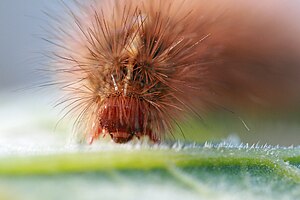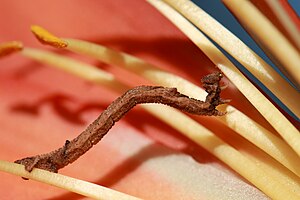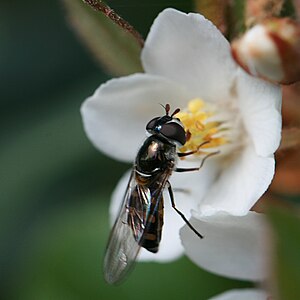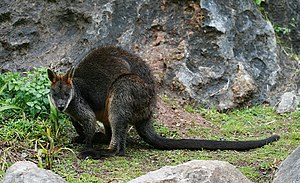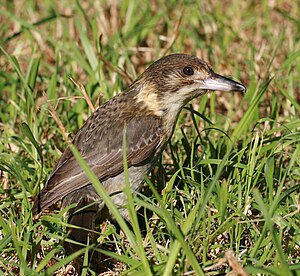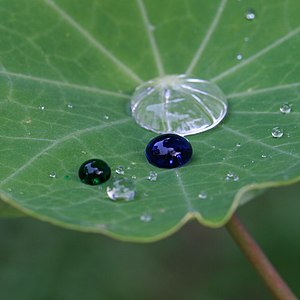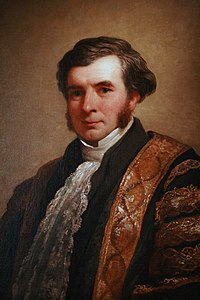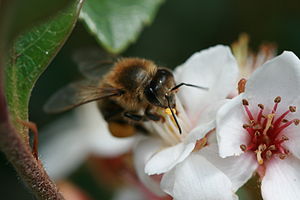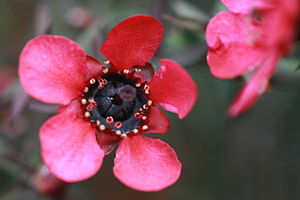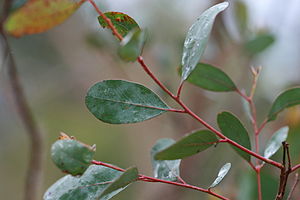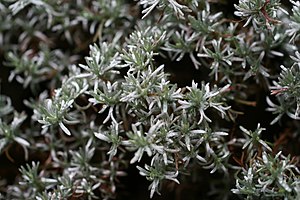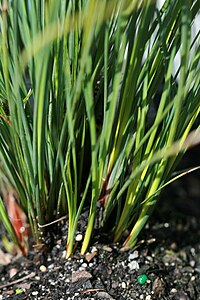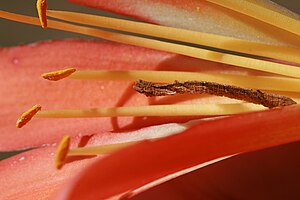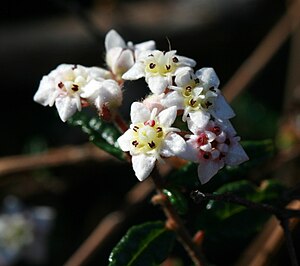User:99of9/SmallGrant
Wikimedia Australia graciously awarded me a Small Grant to contribute to the purchase of a Canon EF 100mm F2.8L Macro IS USM lens. This document is to provide a pictorial report on the project and its outcomes, and my observations as I get to know the lens. All of my recent uploads with 100mm in their exif used this lens (see this category), but I've selected a few for the galleries below.
Project cost and objectives[edit]
Australian Wikimedians have a strength in photography, but apart from the contributions of a few other users, we do not have much high-quality coverage of Australian insects or small flowers. The goal of my purchase is to increase that coverage with high-quality encyclopedic images (primarily in the Sydney region).
The lens is expensive (I got it for $905.95 including $75 shipping from an online importer... under the $1000 price point where GST kicks in). Add on $50 for a UV protector. That means this one lens is worth more than my DSLR camera body! WMA pitched in $200, which certainly helped make the cost bearable. As long as it lasts a few years, I think it was worth it for reasons I'll discuss below.
In my grant application, I anticipated that "at least 20 image opportunities worthy of article space per year will only be possible with a macro lens, but the lens will probably be used for many more". Since I've reached 26 images in use within two months, I guess it's time to write this report!
Over the last couple of years I've been heavily involved in the peer-review processes at Commons (Valued Images, Quality Images, and Featured Pictures). To anyone with a DSLR camera, who actively contributes to Commons, I'd suggest participating in these forums, and submitting your best images. (If you don't have a DSLR, Valued Images still applies, and a good point-and-shoot can also achieve Quality Images.) It's usually a humbling experience, so don't expect glory to be heaped upon you, but what you will get is specific advice on what you should try to improve in your photography. You could write off the criticism because it mostly comes from amateurs, or you could embrace it, and see where it takes you. I've seen my own photography (and that of many others) transformed by this free advice. A great educational photo is subtly different from a great wall-hanging photo, and the quality of free encyclopedic Australia-related content can only benefit if we learn from and teach each other.
I applaud the WMA committee for the Camera equipment program. Continuing to back volunteer photographers focused on providing educational images, by supporting the upkeep of high-quality equipment, will give us a unique opportunity to document and share our country.
If you're an Australian Wikimedian, and haven't yet joined WMA, please consider joining. It's a great way for us all to get organized to achieve our common goals.
But I should get back to telling you about the lens...
Micro Australia[edit]
Firstly, and most obviously, it's a macro lens. The maximum magnification is 1:1, which means the size of the object is reproduced in full on the sensor. My Canon 400d has a sensor size (APS-C) of 22.2 x 14.8 mm, so if need be it can fill the frame with an object just over 1 cm in size. Here are some of the smallest shots I've uploaded:
-
Spilosoma canescens (Dark-spotted Tiger Moth), did you know the bristles have tiny barbs sticking out of them?
-
 Spilosoma glatignyi (Black and White Tiger Moth) (NEW ARTICLE)
Spilosoma glatignyi (Black and White Tiger Moth) (NEW ARTICLE) -
... prolegs (cropped to show detail)
-
Unidentified caterpillar in Clivia miniata
-
 Apis mellifera (Western honey bee)
Apis mellifera (Western honey bee) -
Melangyna viridiceps (Common hover fly)
Prime lens n00b[edit]
I've never used a prime lens before. That means it has a fixed focal length (here 100mm), which prohibits "zooming" in or out. The benefits of prime lenses include sharpness, minimal chromatic aberration (coloured fringes around the edges of objects), and less moving parts which hopefully makes it cheaper or more durable compared to the equivalent zoom lens. I was a little apprehensive about this, because it means that to compose an image well, you need to be a particular distance from the subject. But it turns out that most insects and plants don't care if you walk up close to them pointing a camera. Birds and mammals (gallery following) care a lot more so the fixed focal length is inconvenient. They also tend to be bigger, so the macro feature isn't neccessary. Nevertheless, if you can get to the right distance, it's a great lens for portraits, because it's very sharp, and gives a nice background bokeh. My biggest embarrassment so far was getting Anthony Albanese to agree to a photo, pointing the camera at him, and then realizing I had to walk about 2 metres further back to fit in more than just his nose!
-
 Aythya australis (Hardhead), male
Aythya australis (Hardhead), male -
 Wallabia bicolor (Swamp Wallaby)
Wallabia bicolor (Swamp Wallaby) -
Cracticus torquatus (Grey Butcherbird), juvenile
Low light[edit]
One feature of this macro lens that most don't have is image stabilization (in two of the three dimensions). This is most important in low-light situations. It is most effective at longer distances, so it doesn't necessarily help on the microscopic scale, where you either need to use a tripod or seek good lighting. I have a cheap and light tripod, but rarely carry it with me (the only photos I used it for in this report were the Spilosoma caterpillars, the water droplets and Greg Combet below). Combine image stabilization with a reasonably large-diameter lens (67mm) to let in as much light as possible, and a reasonably wide-aperture (f2.8), and you can get an unblurred portrait shot even in low light:
-
Surface tension of water droplets, with an exposure time of 1/8th of a second on a tripod
-
Greg Combet, with an exposure time of 1/25th of a second on a tripod
-
Charles Nicholson painting, with an exposure time of 1/80th of a second handheld
Depth of field[edit]
One of the chief difficulties of macro photography is a narrow depth of field. At wide apertures for tiny subjects, the sharp zone of the subject is only millimeters deep. That's quite nice for getting a smooth aesthetically pleasing background, but it makes it hard to capture the whole of your subject. Sometimes you can get a good angle exactly perpendicular to a long subject. Other times you just accept the fact that only the eye (the most important focal point) of an animal will be in sharp focus. If you've got a stationary subject, you may even resort to focus stacking (combining multiple images with different parts of the subject in focus). I haven't got into that yet, but the effects of limited depth of field show up in all of these images:
-
Apis mellifera (Western honeybee)
-
... another pose
-
Periplaneta fuliginosa (Smokybrown cockroach) laying an egg package
-
Leptospermum (Tea tree)
-
 Eucalyptus camphora (Broad-leaved Sally)
Eucalyptus camphora (Broad-leaved Sally) -
 Anigozanthos (Kangaroo Paw), red
Anigozanthos (Kangaroo Paw), red -
Anigozanthos (Kangaroo Paw), yellow
Discovery and identification[edit]
One of my favourite ways of contributing to Wikipedia is to take a great photo of a species that does not yet have an article. I then start a stub, and watch with glee as other editors expand it into a beautiful little reference for any internet user interested in the wonderfully diverse flora and fauna of Australia. Having access to the small-scale is fantastic for this interest. There are there so many species of insects and plants, that you can usually find something interesting even in your own backyard or neighbourhood park. And because they're less iconic than big hopping marsupials, Commons categories are often almost empty.
-
 Eumorphia prostrata (NEW ARTICLE)
Eumorphia prostrata (NEW ARTICLE) -
 Persoonia oxycoccoides (NEW ARTICLE)
Persoonia oxycoccoides (NEW ARTICLE) -
Lomandra confertifolia (NEW ARTICLE)
-
Lomandra confertifolia (NEW ARTICLE)
This hobby comes with a challenge... the difficulty of identification. I often spend more time trying to identify my subject than I do taking or processing the photo. One thing that helps is to make sure you take lots of photos of different bits/angles of the subject, even if they're not aesthetically pleasing. For example, when you try to follow a taxonomic key of a wildflower, it will often ask you about leaves, when all you cared about was the flower. Another thing that helps is access to the crowd-sourced wisdom of specialists on Wikipedia. In some cases I've put an image in a category like Category:Unidentified insects, and come back a few days later to find some very good suggestions about which branch up the tree of life I should examine. For those of you reading this, the gallery below are my challenges for you. In some cases I've written to museum experts (who are often very generous with their offers to identify), but even they are sometimes reliant on high quality photographs from the internet. I currently have two pet caterpillars because the Australian Museum asked me to raise them to their moth stage so they could be definitively identified, so that my caterpillar pictures can be used for later caterpillar reference. I guess their collections are full of the moth form because they're easier to preserve?
-
Unidentified caterpillar in Clivia miniata
-
another angle... pretending to be a stick
-
tiny unidentified
antwasp (thanks Anne!) perched on a thyme leaf -
unidentified ant found under a brick in my backyard
Ignore All Rules[edit]
I'll finish with a picture that's unconventional in many ways, but is one of my favourites. WP:Ignore All Rules even applies to photography sometimes! A 100mm (equivalent to 160mm due to the crop factor of an APS-C) macro lens is possibly one of the worst choices of lens for a landscape photograph. But I saw this narrow tunnel of snow stretching into the distance ahead of me, and found that because the long lens has less perspective distortion, it invites the viewer right into the picture. Come explore Australia... the snowy wonderland.

 Kanangra-Boyd National Park - Australia defies stereotyping.
Kanangra-Boyd National Park - Australia defies stereotyping.- Many thanks again for your support Wikimedia Australia.
- Toby Hudson
- 7th September, 2011
- Many thanks again for your support Wikimedia Australia.
